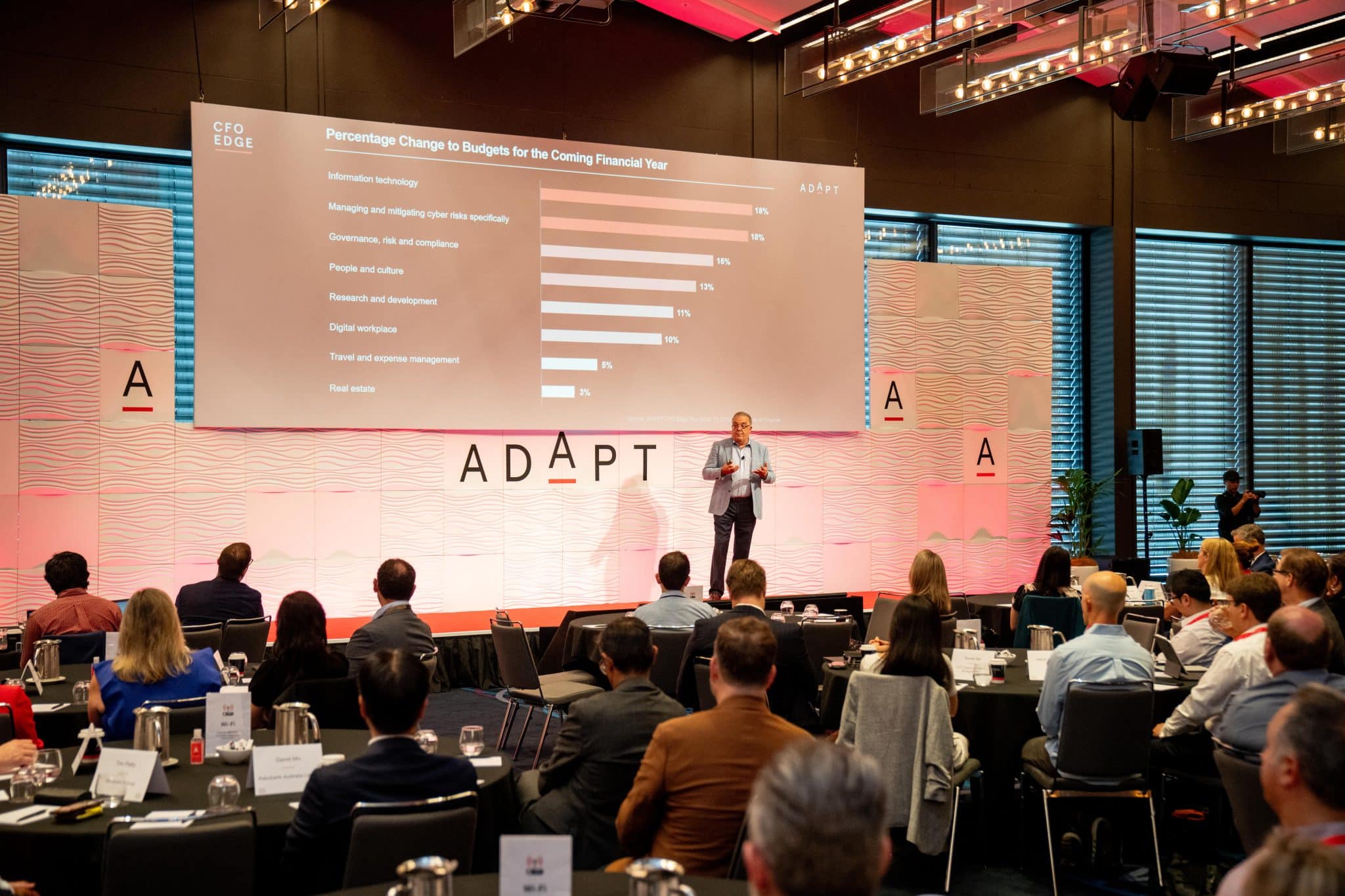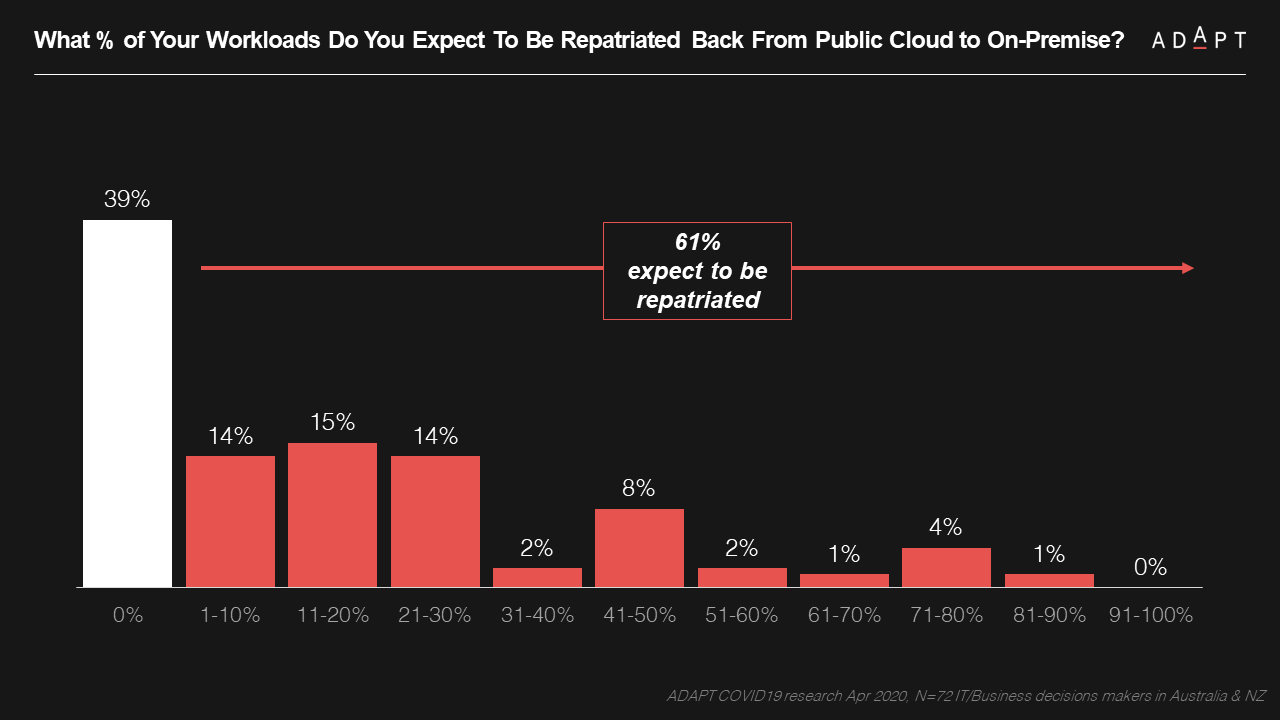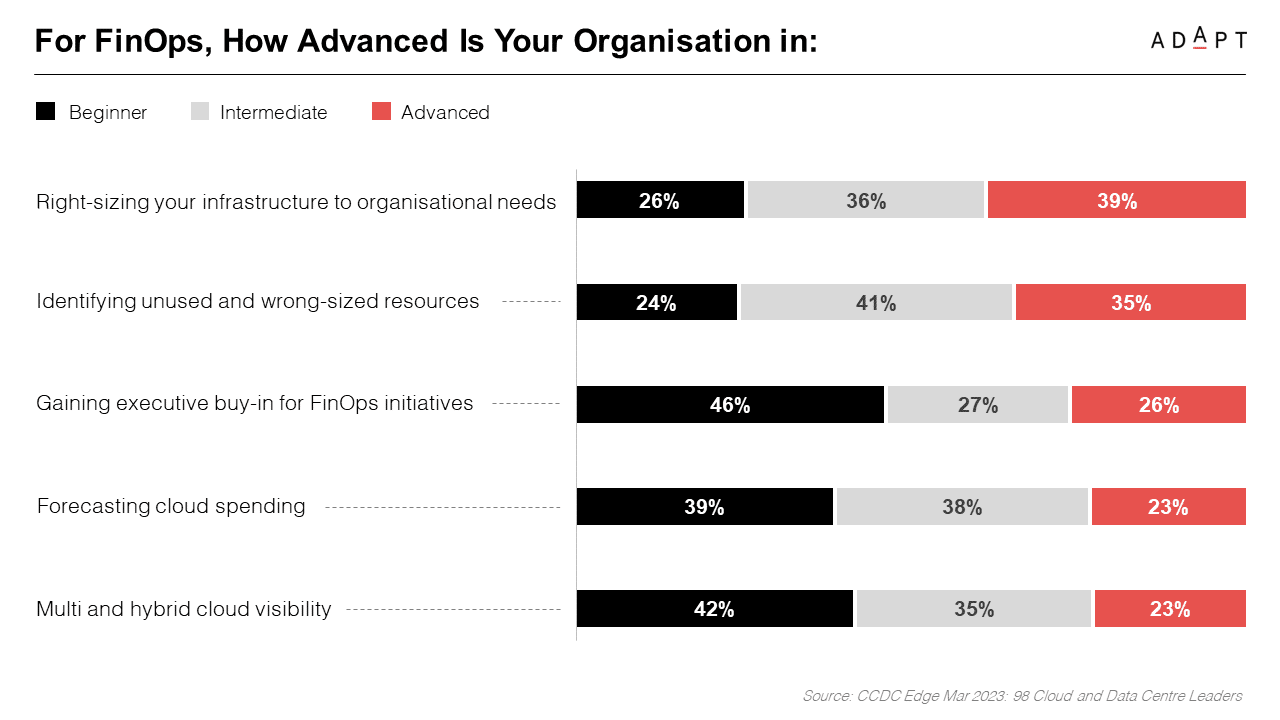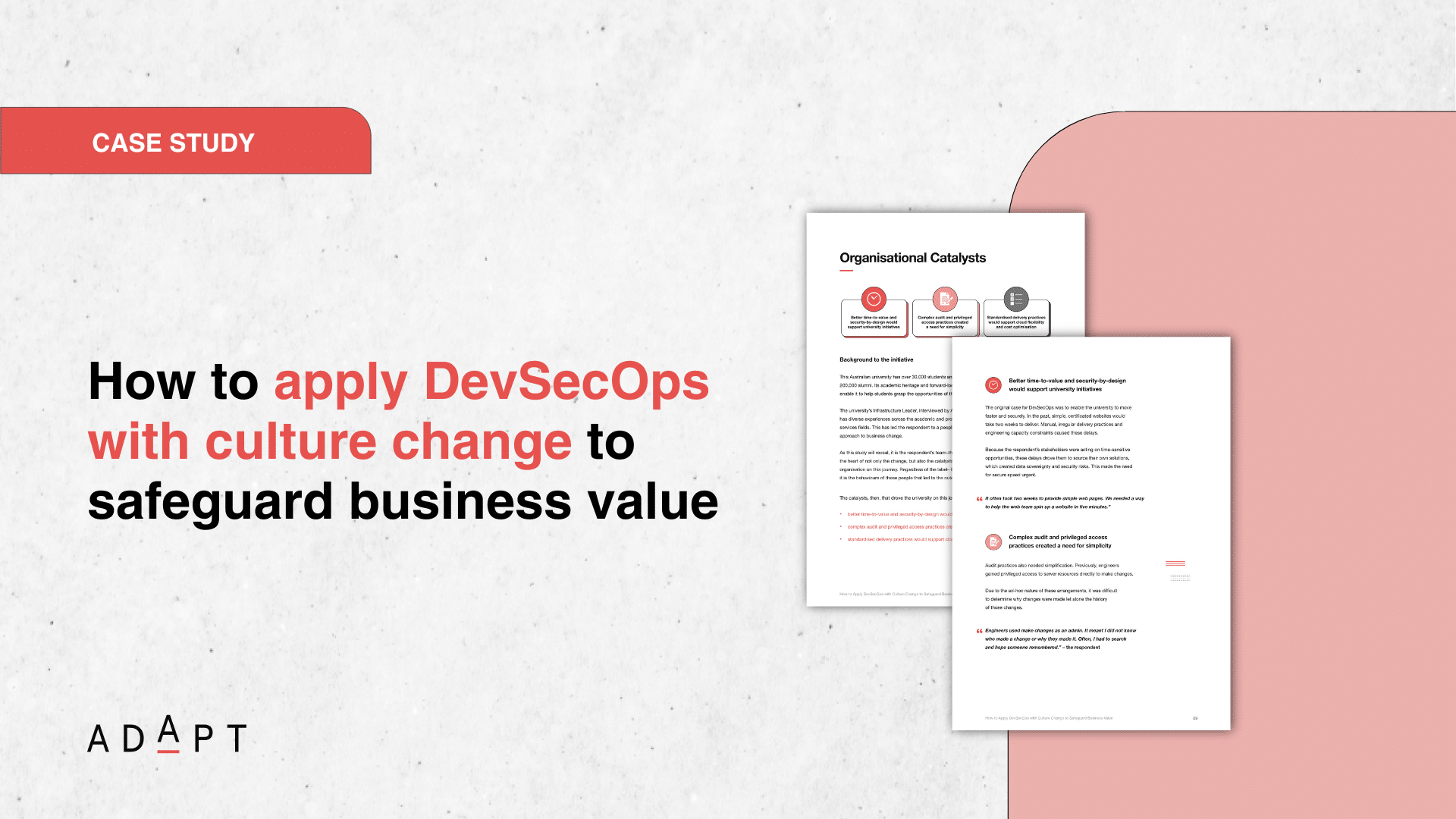Leverage ADAPT’s Cloud Data to Lead Cost-Optimised Cloud Adoption
ADAPT's Research Keynote sheds light on how CFOs use financial data, prioritise initiatives, tackle project delivery challenges, and navigate investment trends and innovation in Australia.
Explore Australia’s evolving cloud landscape with insights from the ADAPT Cloud Migration Study, reflecting the perspectives of 1800 Australian CIOs and infrastructure leaders.
In this landscape, a noticeable slowdown emerges, which prompts an analysis of various factors affecting the adoption of public cloud workloads, as well as the practicalities of cloud repatriation.
Considering various factors such as cloud provider preferences, OpEx funding models, and CFO scrutiny, the dynamics can be quite complex.
ADAPT’s Research Keynote sheds light on how CFOs use financial data, prioritise initiatives, tackle project delivery challenges, and navigate investment trends and innovation in Australia.
These insights provide a comprehensive understanding for navigating the complexities of cloud adoption and financial leadership within organisational landscapes.
ADAPT’s Research and Advisory clients can read the full report, ADAPT Cloud Migration Study.
CFOs Lead Organisational Transformation in Cloud Cost Management
Chief Financial Officers (CFOs) are leading in transforming how organisations manage cloud-related costs. Beyond traditional financial stewardship, they ensure that investments in cloud services align seamlessly with strategic financial goals.
This stewardship extends into the evolving landscape of cloud technology. By scrutinising intricate cloud service costs, CFOs cultivate transparency and clearly understand how these costs contribute to the organisation’s overall value proposition.

Their active engagement in budgeting and planning reflects a holistic approach to resource allocation, integrating cloud-related costs into broader financial strategies.
CFOs are crucial in aligning cloud expenditures with the value derived by the organisation, leading efforts to reassess cost structures and expectations amid a shift in anticipations.
Spearheading initiatives for tangible benefits, such as cost efficiency, CFOs adapt financial strategies to the dynamic nature of cloud technologies. They advocate for a value-driven approach and optimise costs through strategic manoeuvres, continuous evaluation, and risk mitigation.
This showcases their adept navigation of cloud-related intricacies, signalling a broader organisational shift toward efficient spending and maximising value in the rapidly evolving cloud technology landscape.
Public Sector Embraces Cloud for AI, CFOs Drive Cost Optimisation
A recent survey conducted by public sector tech provider Relativity reveals that most public sector agencies consider migrating to the cloud a top priority.
According to recent findings, 75% of surveyed agencies anticipate a transition to the cloud within the next three years. However, there is a suggestion for quicker adoption based on the analysis.
Highlighting the urgency is John Wallace, an APAC government advisor and former Chief Data Officer with law enforcement experience, emphasising the agencies’ keen interest in harnessing cloud-enabled AI for enhanced data capabilities and insights.
The cloud, as Wallace notes, presents substantial advantages in securely capturing, storing, and utilising data, especially with the integration of analytics and the latest AI innovations.
Wallace goes on to underline the critical role of the cloud in supporting new AI applications, including generative AI, which heavily relies on cloud infrastructure.
However, amidst the benefits, he expresses concerns about the growing security challenges associated with cloud-enabled generative AI.
He urges the public sector to build resilience against evolving cyber and data threats, emphasising the importance of a proactive approach.
Expressing further concern about the timeline, Wallace notes that waiting three to five years may be too long, particularly considering the escalating rate of data proliferation and cyber-attacks that could impact agency priorities and missions.
He stresses that moving to the cloud is a crucial component of the defence strategy, alongside the imperative need for robust cyber security and data governance frameworks that evolve in tandem with the complexities of the data and technology landscape.
Additionally, the survey identifies a noticeable gap between forecasted and actual cloud adoption rates, suggesting that agencies may progress slower than anticipated.
This variance prompts a deeper exploration into the factors influencing the pace of cloud adoption in the public sector.

An ADAPT study unveils that 61% of organisations are contemplating workload repatriation, a strategic shift where workloads or data are moved from the cloud back to on-premises infrastructure or a different cloud provider.
Economic drivers behind these decisions include considerations for cost optimisation, changing cost dynamics, performance and security concerns, flexibility, and control, as well as shifts in technology and vendor relationships.

Furthermore, the role of Chief Financial Officers (CFOs) becomes prominent as they question cloud-related costs and drive a shift in cost expectations.
CFOs, acting as financial stewards, scrutinise the costs associated with cloud services, ensuring transparency and aligning expenditures with the overall value derived by the organisation.
This shift reflects a broader organisational strategy towards optimising spending and maximising value in the rapidly evolving landscape of cloud technology.
Public Sector Drives Accelerated Cloud Adoption and AI Innovation Amid Economic Challenges
Adopting cloud technologies in the public sector brings technical and economic challenges into focus, with a notable concern being the potential emergence of a ‘black hole.’
This scenario, marked by underutilised cloud resources leading to wasted expenditures, requires addressing challenges such as resource overprovisioning.
Commonly, allocating excess resources creates a ‘black hole’ effect, funnelling financial resources into unused cloud assets and diminishing the promised economic efficiency of cloud adoption.
This situation represents agencies paying for cloud resources with little value due to underutilisation, straining budgets and diverting funds from crucial areas.
To ensure long-term economic viability, active measures for sustainability, including efficient resource allocation and optimisation, are necessary.
The accelerated push for public sector cloud transition, driven by the urgency to leverage cloud-enabled AI amid the challenges of COVID-19, is crucial for enhancing data capabilities and fostering insights-driven operations.
Despite recognising the pivotal role of cloud adoption, concerns about security challenges associated with cloud-based generative AI have been raised.
Establishing resilience and robust cyber security frameworks is deemed essential. While the government acknowledges AI’s transformative potential, it remains mindful of privacy and security risks.
The anticipation and excitement for ongoing innovations in public sector cloud adoption and AI technologies, leading into 2024, mark a rapid evolution in these domains.
Australian Organisations Embrace FinOps
Examining the FinOps concept, Australian organisations proactively address challenges in cloud spending forecasts.
FinOps, focusing on the financial aspects of cloud management, aligns with the need for effective cost governance discussed earlier.
As Australian entities navigate the complexities of cloud adoption, incorporating FinOps practices becomes crucial for transparency, accountability, and strategic economic planning.
This holistic approach, combining technological advancements and financial acumen, will be instrumental in realising the full economic benefits and ensuring the sustainability of cloud adoption in the public sector.

Public Cloud Workloads in Australia Plateau at 38%, Prompting Strategic Shifts and Revised Expectations
The ADAPT Cloud Migration study highlights a significant plateau in public cloud workloads in Australia, holding steady at 38%.
This contrasts previous years of consistent year-over-year growth, prompting a closer examination of the factors influencing this current landscape.
Despite optimistic forecasts of 52% of workloads to be in the public cloud by 2026, the figures still need to catch up.
Various factors contribute to this deviation, including heightened budget scrutiny, the rapid but potentially saturating cloud adoption during the pandemic, complexities in managing hybrid multi-cloud environments, challenges with legacy infrastructure, and concerns regarding data security.
Revised Expectations for Future Cloud Workload Growth
The same study forecasts a rebound in public cloud workloads to 55% by 2025, signalling resilience and optimism in cloud adoption.
However, this projection reflects a slight decline from earlier expectations set in 2024, underscoring the dynamic nature of cloud migration trends.
Factors Influencing the Revised Expectations:
- Budgetary Scrutiny and Cost Optimisation: Organisations are exercising caution in cloud spending, emphasising a strategic focus on cost efficiency.
- Pandemic-Induced Rapid Adoption: The surge in cloud adoption during the pandemic prompts a reassessment of strategies, potentially contributing to the current adoption plateau.
- Complexity of Hybrid Multi-Cloud Environments: Managing workloads across diverse cloud platforms and on-premises infrastructure introduces complexities impacting adoption speed.
- Legacy Infrastructure and Tech Debt: Challenges associated with existing systems act as barriers, necessitating a measured approach and emphasising modernisation.
- Data Security Concerns: Heightened concerns about data security influence a deliberate approach to cloud migration, prioritising protecting sensitive information.
Strategic Steps for Organisations
Organisations are adopting strategic steps to navigate the evolving cloud landscape in response to revised expectations and challenges.
Incremental Cloud Migration: Organisations favour a gradual approach, moving workloads instead of rapid transitions.
This minimises disruptions, optimises migration, and addresses complexities associated with hybrid and multi-cloud environments.
Balancing Costs with Flexibility: Organisations emphasise balancing costs with flexibility.
Increased budget scrutiny prompts a strategic focus on cost optimisation while ensuring cloud services’ agility and scalability benefits.
This involves exploring innovative cost management strategies, leveraging cloud-native tools, and embracing flexible pricing models.
Conclusion
In conclusion, Australia’s public cloud workloads plateau at 38%, prompting a strategic reassessment amidst budget scrutiny and security concerns.
The forecasted rebound to 55% by 2025 signals resilience, while CFO-led financial optimisation underscores a maturing understanding of cloud adoption.
As organisations navigate these dynamics, a dynamic landscape emerges, emphasising the need for strategic refinement in cloud adoption strategies.
ADAPT’s Research and Advisory clients can read the full report, ADAPT Cloud Migration Study.
























